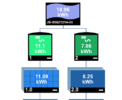The fun never stops with Tesla Energy. We finally got everything installed and got PTO, and I noticed that our production always caps out at a suspiciously exact 12.5 kW. I expected Tesla to install two 7.6 kW inverters (for a 7% undersize) or at least a 6+7.6. Instead we have two 6 kW SolarEdge inverters, for an inverter undersize of around 30%! I wish I had done a lot more research up front, but did not expect to need to become an expert on solar systems before ordering. (2 x 6kW was always what the system was designed with, so it's not a matter of them not delivering what was promised)
So -- is this actually a problem? I'm getting set up with a SolarEdge account so that I can at least see how much clipping we're getting. We have two sets of panels in slightly different orientations, so this could be a non-issue and only causing an actual loss during the hour or so that the sun is hitting both sets of panels at a good angle. Or each could be clipping at different times, and we're actually losing a good amount of daily production. I guess I'll find out soon. For those of you with 16 kW installs, what inverters do you have?
What's especially annoying is that the price difference between the 6 kW and 7.6 kW SolarEdge inverters is only around $175! Had I known what to ask for I would have pushed for the bigger inverters.
I should add: on sunny days (basically every week for the past week) -- we generally have about 100 kW total production daily. So we're still in good shape, though add in car charging and air conditioners and that gets eaten into!
So -- is this actually a problem? I'm getting set up with a SolarEdge account so that I can at least see how much clipping we're getting. We have two sets of panels in slightly different orientations, so this could be a non-issue and only causing an actual loss during the hour or so that the sun is hitting both sets of panels at a good angle. Or each could be clipping at different times, and we're actually losing a good amount of daily production. I guess I'll find out soon. For those of you with 16 kW installs, what inverters do you have?
What's especially annoying is that the price difference between the 6 kW and 7.6 kW SolarEdge inverters is only around $175! Had I known what to ask for I would have pushed for the bigger inverters.
I should add: on sunny days (basically every week for the past week) -- we generally have about 100 kW total production daily. So we're still in good shape, though add in car charging and air conditioners and that gets eaten into!



